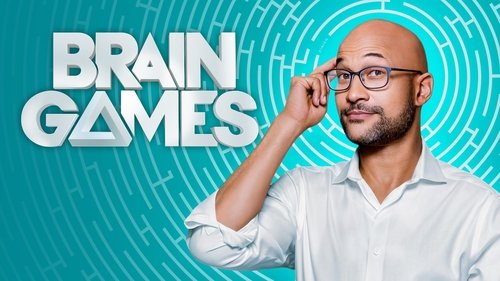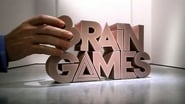Dalbert Pringle
Even though an average (human) adult brain weighs only 3 lbs. and barely generates more than 12 watts of power, it's certainly a mighty complex mass of "grey matter" that can readily store and retrieve a million bits of information and help an average person to perform all sorts of tasks, some surprisingly complicated, some not.The 2-disc set that I watched contained 3, 1-hour episodes from the best of TV's "Brain Games" in its first season of 2011.Set in Las Vegas, Nevada - This is a very slick production that plays "perception/memory" games with its audience in order to find out if the viewer is, indeed, really paying attention (which, in most cases, we aren't).For the most part - I found Brain Games to be actually quite entertaining - But, when trying to get its point across - This show did, sometimes, resort to a fair amount of superfluous "hocus-pocus" type stuff.
plonskyks
Brain Games is a documentary series about the human brain and how it works. The episode, "Battle of the Sexes" was a compilation of experiments and games testing the biological differences in the female and male brains. Because my project is based off of the physical and behavioral differences among men and women and how those differences affect the law, this episode of Brain Games directly affects my civil rights question. My own experiments I have conducted are inspired directly from this show, and they will help prove or disprove stereotypical differences in the two genders. "Battle of the Sexes" covers three major differences in men and women: the eye for detail, competitive drive, and spatial reasoning. The first experiment was a picture of seven squares of the color red. Both men and women were asked how many different shades of red they could see; The majority of guys only saw three to five shades of red, whereas the majority of women could see six or all seven almost immediately. Women's brains are hardwired to see more shades on the red orange spectrum, and they are typically more likely to pay attention to detail. One theory behind this biological difference is that millions of years ago, it was an advantage for women to see the differences in shades of red to find nutritious berries while scavenging. The female brain is proved throughout this experiment and many others to be better at noticing detail in color and other things than the male brain. This means that the stereotype of women noticing things better and having a sharper eye for detail is true. The eye-for-detail stereotype was proved again in the second experiment through a game tested on both men and women. A list of ten random challenging tasks titled "Read All Directions Carefully" is placed in front of a man and a woman in separate rooms as they compete to finish all tasks the fastest. The tasks include applying lipstick, doing jumping jacks, spinning in circles, etc. At the end of the list, it says "ignore all of these challenges and sign your name on the bottom of this page." On this show, 75% of the women tested simply signed their names on the bottom, winning the game, whereas only 20% of men signed and won.Although women may be better at noticing detail, men are proved to have the upper hand in spatial reasoning in this episode of Brain Games. In the first spatial reasoning experiment, One shape, a parallelogram, is shown at the top of a poster and four groups of shapes are shown at the bottom. The task is to figure out which group of shapes makes up the parallelogram shown at the top. Most guys got the right answer more than girls did, proving they have a better sense of spatial reasoning. This was proved once again in the second spatial reasoning test when two different kinds of directions were read aloud to men and women. Most men have an easier time understanding directions when miles and cardinal points are included, whereas women have an easier time following directions using physical landmarks. Spatial reasoning means men are naturally better at finding cardinal points like north and south, making this experiment another valid test proving men have the advantage in spatial reasoning. One explanation to this is millions of years ago it was a man's job to head out the wilderness, track and kill animals, and then find their way home. This gives them the advantage among building things and picturing where things are placed, which may contribute to the male dominance in things like the STEM field and STEM related careers.This episode of Brain Games proves through a few simple experiments that men and women really are biologically different in several ways, and it affects their behavior to gain the advantage in different areas like spatial reasoning or following directions. Not only is this is helpful to further our understanding of the two genders, but it also allows to think about how genders should be treated in the eyes of the law. If men and women simply do not have the same strengths and weaknesses, should they be treated completely equally in all aspects of the law?
amgod-18233
This show is far from scientific, intellectual or even honest. For the first perhaps nine episodes they actually provide some level of honesty, entertainment, and a decently simplified scientific explanation. After that they abandon honesty, they LIE to you, offer pseudo-scientific explanations as well as abandon creativity. They decide that their audience is a collection of absolute imbeciles. They masquerade fancy slight of hand type tricks as explanations of stress, and memory. In season three they do not abandon this, they begin to resort to what is rather obviously bad acting. Their experts almost always have a pretentious tone. Their goal is to fool those without a shred of common sense to continue watching. If you are looking for something intelligent or even entertaining look somewhere else.
shannon-977-42041
I loved this show until I found out they lie. I just watched a segment about 3D where they brought out a plate of food, and a cheese plate and a glass of water with flowers in it. They then tried to convince you that the stuff they brought out was actually printed on paper (2D).. and that your brain had been "tricked". The problem is, the stuff they brought out WAS real, and through not so clever editing, they LIED to make the illusion seem legit. I know this because the water in the glass moved around slightly, impossible for "printed" water to do. There are all other giveaways that segment was rigged if you look closely.... shadows that are present on the real plate of food become much less pronounced on the "image" that is supposed to have tricked you.


